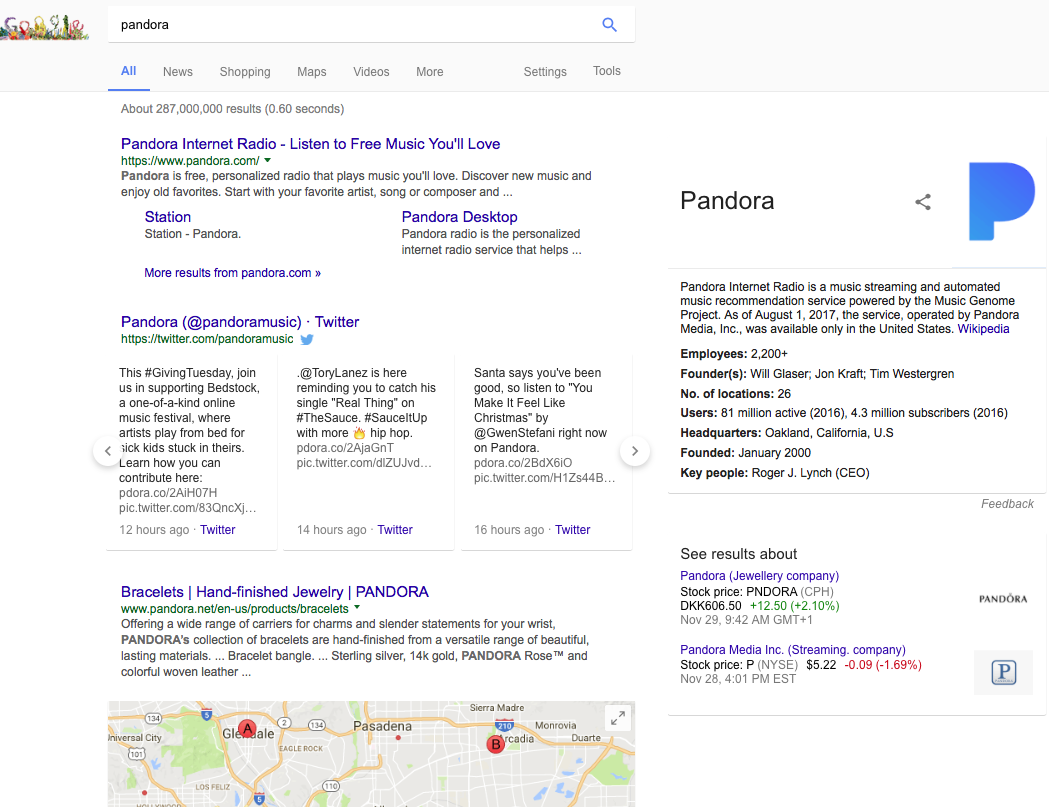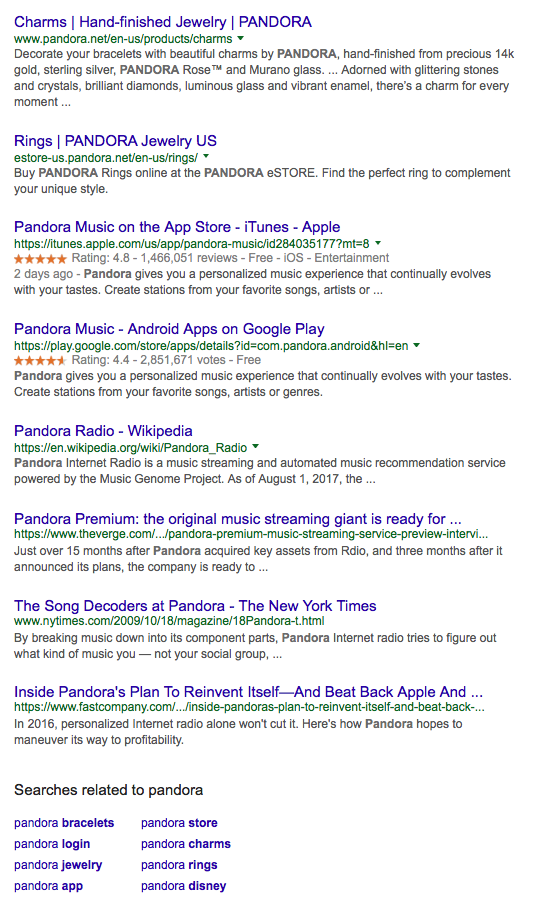
Reposition Pandora

Tools:
SPSS, Qualtrics, Google Trends, Google Correlate, Google Sheets
Team Members:
4 undergraduate students
Role:
Analyst, Recommender
Course:
MKT 402, Market Research, Fall 2017
Time to Reposition
As a college student, listening to music on demand plays a big part in our lives as we are walking to class or cranking through a 15 page paper. Spotify is a popular choice for my demographic because of the student pricing, which is now bundled in with a Hulu membership. Needless to say, Spotify is doing well against its other competitors in the music streaming arena.
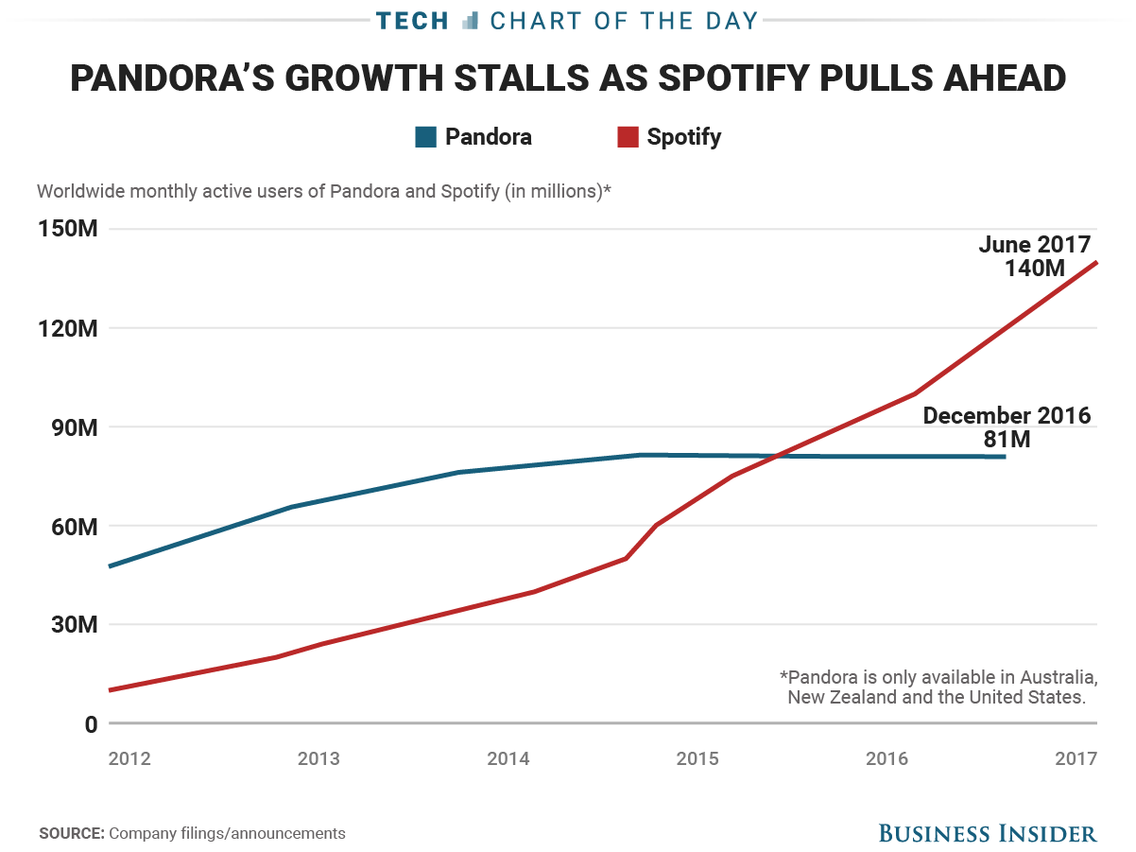
Source: Business Insider
What puzzled my group was why Pandora, which is the oldest music streaming service, was lagging behind newcomers like Spotify or Apple Music. It has the most sophisticated music algorithm with the Music Genome Project compared to its competitors. The two strategic problems we came up with during our research was: A) Pandora has a lack of positioning and brand awareness B) The platform and business model has issues that was deterring potential customers away.
- PROBLEM A -
Lack of positioning
One of the main things we noticed was the company claims they are a music streaming service (in technical terms, they are). However, when you Google-ed Pandora, the website link comes up as "Pandora Internet Radio." The lack of clarity in terms of what exactly where Pandora stands was holding the company back as consumers are unsure of what the company has to offer.
Outdated
Being that it is the original digital music platforms still available, potential users might think that because they are older, they are more outdated. This results in them turning away from Pandora. We did a Google Trends analysis for 2016-2017, where there was a visible dip in search interest on March 2017. The dip was concerning since they launched the a new Premium service, which was similar to Apple Music and Spotify.
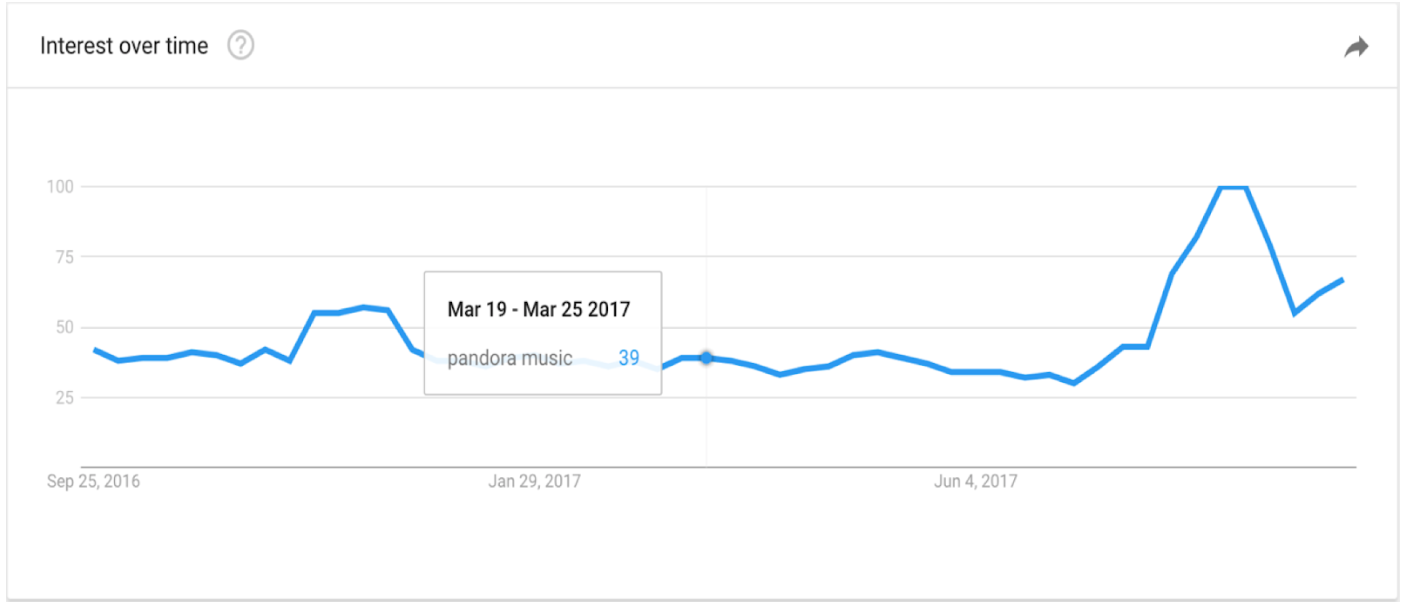
Source: Google Trends
No Brand Awareness
Pandora's key differentiator is their Music Genome Project and has the potential to be their unique selling proposition. We used Google Correlate and Trends to see if there were any strong correlations between Pandora and Music Genome Project. The results were not even close, which is highly problematic. It goes to show people are not associating Pandora with the Music Genome Project at all.

Source: Google Correlate
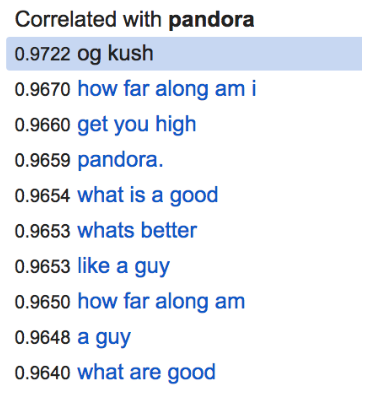
Source: Google Correlate
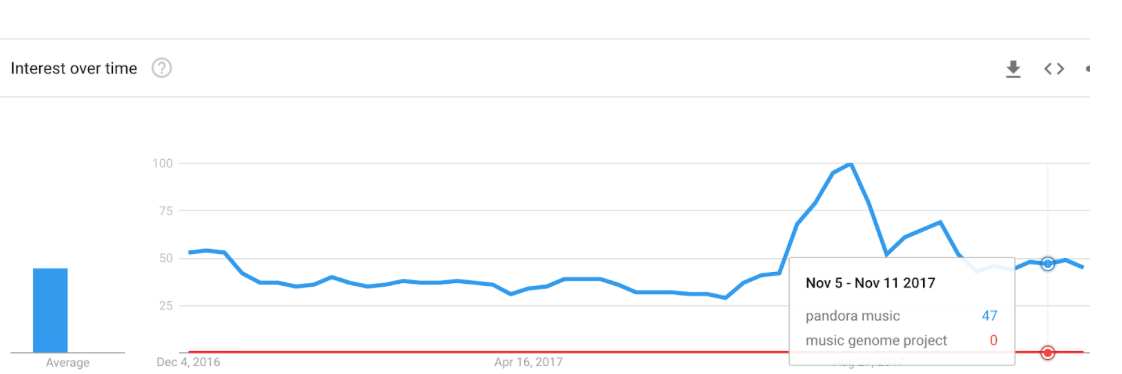
Source: Google Trends
- PROBLEM B -
No Desktop Application
Unlike its competitors, Pandora does not have a desktop application. Having a desktop application allows users to interact from their home screen in an easy and efficient way, rather than using a web player. The desktop application gives user the option to listen to their music offline when there is no internet connection.
High Entry Price
The current entry price for Pandora is $9.99 for premium features. This price tag is simply unappealing to millennial students, who are part of today's target audience as they will become a larger part of the consumer base later on. To make themselves more appealing, Pandora should consider implementing a student discount. That way, once they become student users and graduate, they are less likely to switch over to other music platforms due to the familiarity and user data on Pandora.
- RESEARCH -
In-Depth Interviews (IDIs)
With these problems in mind, we created IDIs to gather primary data and see how prevalent these problems were in Pandora's user base.
Part 1 of the IDIs was more focused on general data and opinions about the music streaming industry. Below is a list of questions we asked:
Result of question 2, part 1

When you think of digital music services, what brands come to mind?
Which service do you personally use? Which is your favorite and why?
What digital music service do most of your peers use or you think they use?
What is the most important thing you are looking for in a digital music service?
We asked these questions because we wanted to see which brands have the most awareness and favorability by the millennial target market. Only 5 respondents named Pandora, but usually after other services like Youtube, Apple Music, and SoundCloud. This shows that Spotify has the highest awareness in consumer's mind AND Pandora does have some awareness. However, when question 2 was asked, no one answered Pandora. Here is what one of the students said in regards to question 2:
I use Spotify Premium. I used to use Pandora, but then they tried to do the Spotify thing. They started charging you for it, but they charge as much as Spotify for half of what Spotify gives you. Spotify gives you the most choices with your music, where you can search pre-made playlists, make your own playlists, follow people, and listen to radio.
Result of question 2, part 2

Part 2 of the IDI focused more on Pandora, whether it is the product, service, or price. Below is a list of the questions we asked:
Do you consider Pandora a streaming service or internet radio?
When you hear Pandora, what are the first 5 things you think of?
Do you know what the Music Genome Project is?
Describe the occasion in which you use Pandora. With who? On what device(s)? Where?
Who you think is THE biggest competitor for Pandora?
Is there anything that you would make you use Pandora over the competitors?
For Part 3 of the IDI, we wanted to test the effectiveness of Pandora's newest ads by showing Big Sean's "Sounds Like You" commercial.
Here are the questions we asked:
Tell me what you know about Pandora after this ad?
Has this influenced your opinion of Pandora?
What could Pandora do to get you as a customer?
What did you learn about Pandora after watching this ad? I would not be surprised if you think nothing because that is what majority of the people said. More importantly, many were confused as to the purpose of the ad and what it was about.
Survey
Using the information we learned through the IDIs, we created a survey asking about Pandora's brand associations, music streaming habits, and pre/post questions about the "Sounds Like You" ad campaign. If interested, you can preview the survey here.
Results
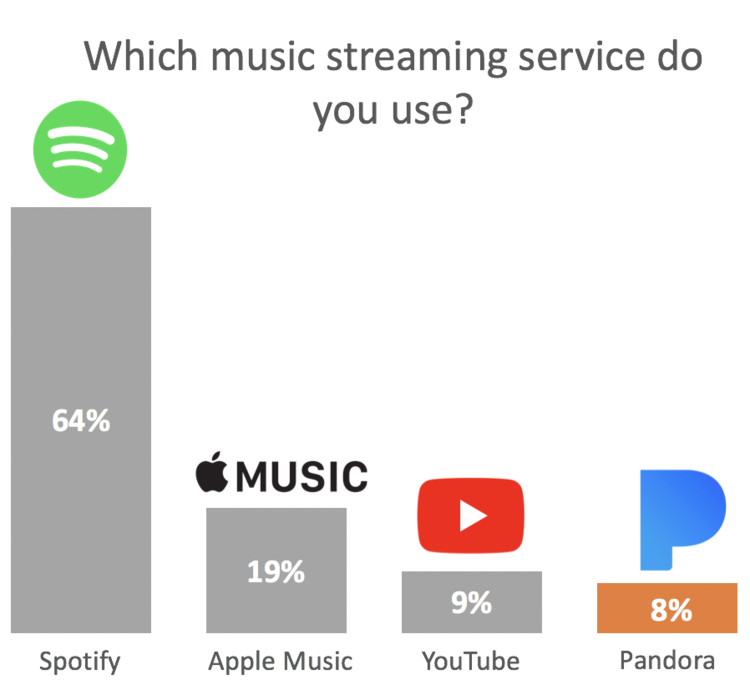
After screening for previous marketing experience, we had 55 qualified responses. Most of the respondents said they used Spotify as their main music streaming platform. This confirmed our previous findings from the IDIs on a larger scale. We also asked when do the respondents listen to music and the top three answers were: in the car, working out, and with friends. Another important question we asked was having the respondents rank nine different features in order of most important to least important. The top three were: available offline, creating playlists, and ad-free. Pandora's competitor, like Spotify, has these features for their users already, while Pandora doesn't. It correlates with why Spotify is the most used platform among our respondents.
Through our survey, we discovered three key customer insights: they dislike listening to advertisements while listening to music, are willing to pay premium to avoid ads, and want the option to listen to music offline. These three consumer insights prove that Pandora's service is incongruent with the desires of customers. Pandora's service is infamous for its large amount of interrupting advertisements and needs internet connection to listen to music. Only Pandora's highest level of subscription allows for creation of playlists, but this would make the company significantly more expensive than its competitors.
Finally, we conducted a measure of how well five adjectives associated with Pandora will measure before and after the "Sounds Like You" advertisements featuring Big Sean. Respondents were asked to rate on a scale of 1 (strongly disagree) to 5 (strongly agree) how well the adjectives related to Pandora.
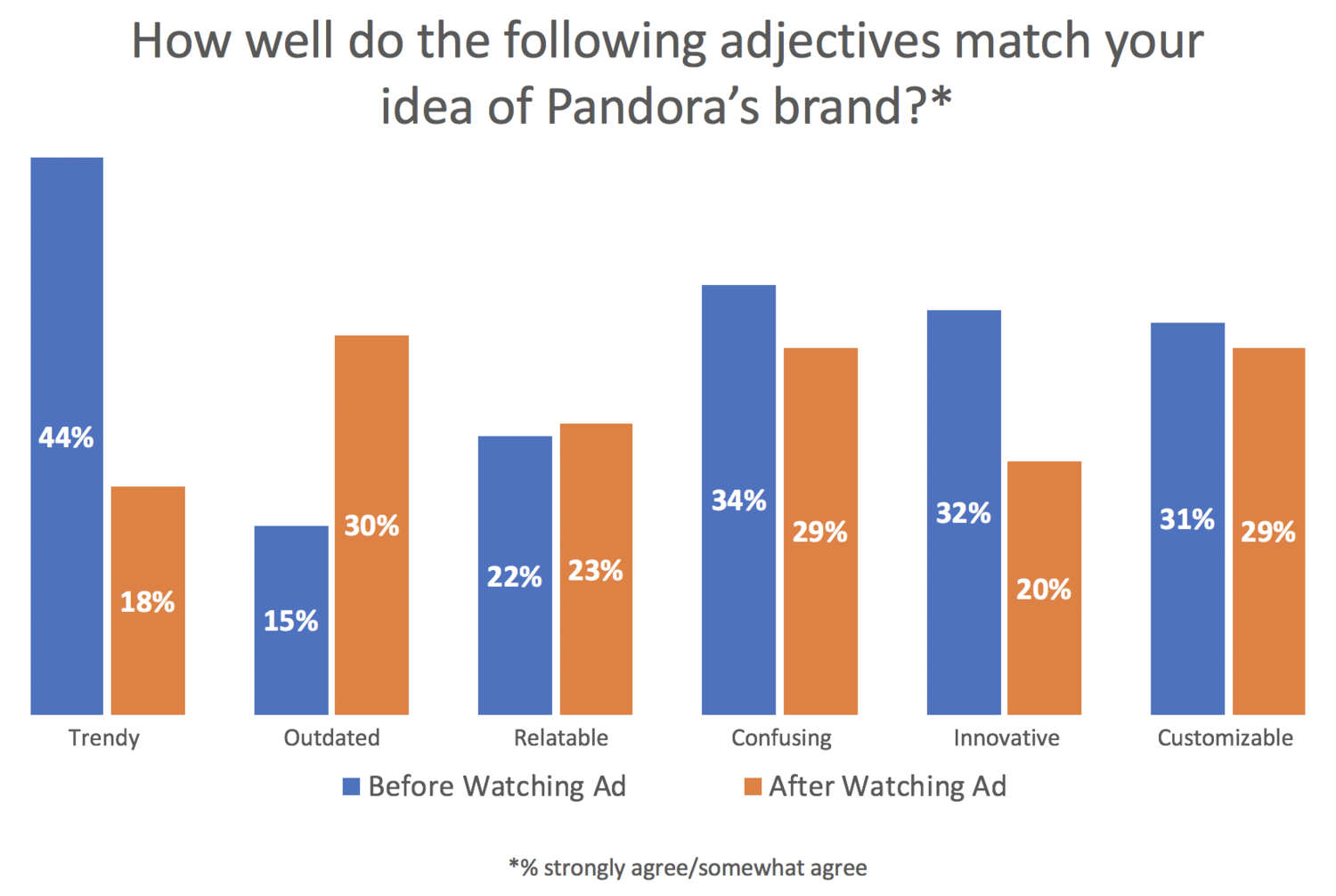
It goes to show having a celebrity in the advertisement might not always help the brand. Pandora should have focused more on what their service and experience they can offer to their users.
- SUGGESTIONS -
*Promote Music Genome Project*
What makes Pandora unique from other platforms is their Music Genome Project, a proprietary music attribute program that Pandora engineers developed in the early years of the company. It can classify over 450 attributes to songs; Spotify has only about a half of that in their algorithm. Hypothetically then, Pandora should be better at suggesting music to its users. Why are they not promoting this and promoting Big Sean on Pandora is beyond me. The Music Genome Project is the company's value proposition and should be their main selling point. By directly saying how their algorithm is more complex and gives better music suggestions, Pandora is indirectly saying other music platforms have not been suggesting the best music.
Reposition the company to streaming
When Pandora first entered the music industry, the streaming business was small and not well-developed. Branding themselves as an internet radio services differentiated them from the early competitors in the streaming business. Times have changed. The streaming music platforms, like Spotify, are more developed and commonly used throughout the world with the younger generation (Spotify has rights in over 20+ countries). Pandora only has two. Pandora's internet radio brand is confusing to potential users to not associate the company as a streaming platform; hence why our respondents thought it was outdated and not on trend.
Create Desktop Application
Spotify has a desktop application, while Pandora doesn't (only have mobile and internet browser platform). Not having a desktop application is a missed opportunity for the company. It makes the music more accessible to people by having it on their dashboard, rather than taking the extra step to open Pandora on a web browser. Having a desktop application can create a more seamless transition between different platforms for users. This gives users the freedom to listen to their music whenever and wherever they want.
Improve SEO on Google and YouTube
When Googling Pandora, the company does show up as the number one search, but Pandora Jewelry brand also shows up. The suggested search, with the exception to one of them, is all related to the jewelry company. YouTube has a similar issue. typing in the word "Pandora" in the search box results in videos that have no connection with the company whatsoever. It causes confusion for people who are trying to learn more about the brand. Improving the SEO can create less confusion, but also more direct search results that can lead to more users in the future.
- REFLECTION -
As a former Pandora user, this project made me realize the importance of changing with time and understanding consumer needs. The fact that Pandora dominated the early streaming industry does not mean that they will hold that position forever. Spotify is continually innovating and rolling out new features and designs that improve their users experience. My personal favorite is how I can seamlessly switch from listening on my computer to my phone with their "Connect to a device" feature. The years I was using Pandora, there were not any significant updates that deepened my experience. I remembered being left frustrated over not having the option to save certain songs and had to create another playlist that reflects that song's style.
Something I would have differently is the number and variety of survey respondents we had. Good researchers know having too small or large of a sample size is not a good thing as both can have its negatives. For a project like this, I believe an ideal amount of qualified respondents would be 150-200 people as its neither too big or small. We mainly had student respondents due to our limited resources. If I were to do this research again, I would spend more time collecting data to ensure it reflects the general population.

